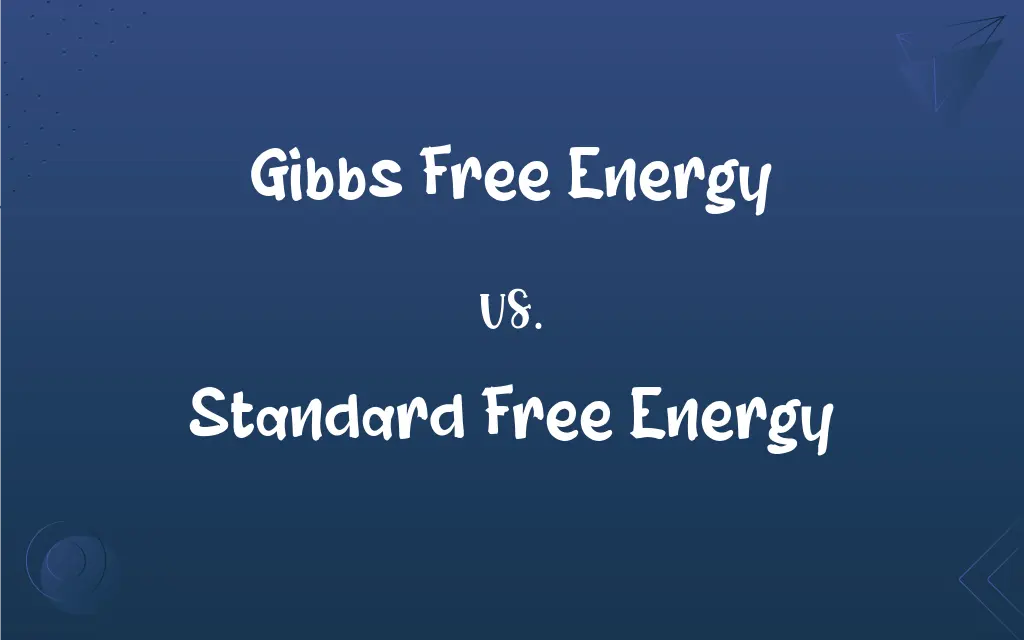Gibbs Free Energy vs. Standard Free Energy: What's the Difference?
By Janet White || Published on December 7, 2023
Gibbs free energy measures the spontaneity of a process at constant temperature and pressure; standard free energy is Gibbs energy under standard conditions.

Key Differences
Gibbs free energy, is a thermodynamic potential that predicts the direction of chemical reactions and non-mechanical work under constant temperature and pressure. Standard free energy, on the other hand, refers to the Gibbs free energy of a reaction when all reactants and products are in their standard states, typically 1 bar pressure for gases and 1 M concentration for solutions.
The concept of Gibbs free energy is crucial in determining whether a reaction will proceed spontaneously. A negative Gibbs free energy change indicates a spontaneous process. In contrast, standard free energy change provides a reference point for comparing the relative energy levels of different reactions under standard conditions, irrespective of the actual conditions.
The calculation of Gibbs free energy involves the enthalpy, entropy, and temperature of the system. This distinction is important for understanding how reactions behave under different environmental conditions.
In biological systems, Gibbs free energy helps in understanding metabolic pathways and energy production. Meanwhile, standard free energy is often used in electrochemistry, providing insights into the feasibility and voltage of electrochemical cells under standard conditions.
The versatility of Gibbs free energy lies in its application to real-world scenarios, where conditions might not be standard. The standard free energy, while more restrictive, is vital for establishing baseline comparisons across various chemical reactions.
ADVERTISEMENT
Comparison Chart
Definition
Measures spontaneity at constant T and P
Gibbs energy under standard states
Conditions
Variable, real-world conditions
Standard conditions (1 bar, 1 M, etc.)
Importance
Predicts reaction direction in real-time
Provides a baseline for comparing reactions
Applications
Broad, in various chemical/biological systems
Mostly in electrochemistry and theoretical studies
Gibbs Free Energy and Standard Free Energy Definitions
Gibbs Free Energy
Key in predicting phase transitions and chemical equilibria.
Gibbs free energy changes signify a phase change in a substance.
ADVERTISEMENT
Standard Free Energy
It provides a reference point for reaction energy levels.
Standard free energy is used to determine the standard electrode potential.
Gibbs Free Energy
Gibbs free energy is a thermodynamic potential indicating reaction spontaneity.
A negative Gibbs free energy means the reaction occurs spontaneously.
Standard Free Energy
Standard free energy is Gibbs energy at standard conditions.
The standard free energy change for a reaction helps compare its feasibility to others.
Gibbs Free Energy
It predicts the maximum reversible work other than PV-work.
Gibbs free energy helps calculate the maximum work a chemical reaction can perform.
Standard Free Energy
Used to calculate the equilibrium constant.
A reaction's equilibrium constant can be derived from its standard free energy change.
Gibbs Free Energy
Represents the balance between enthalpy and entropy in a system.
In Gibbs free energy calculations, a decrease in enthalpy can drive a reaction.
Standard Free Energy
Crucial in electrochemistry for predicting cell potentials.
Batteries' operating voltages are based on standard free energy changes.
Gibbs Free Energy
A determinant of equilibrium position in chemical reactions.
When Gibbs free energy is zero, the reaction reaches equilibrium.
Standard Free Energy
Assists in understanding reaction spontaneity under ideal conditions.
Standard free energy indicates whether a reaction is thermodynamically feasible under standard conditions.
FAQs
How is Gibbs Free Energy calculated?
It's calculated using the formula G = H - TS, where H is enthalpy, T is temperature, and S is entropy.
Is Gibbs Free Energy temperature dependent?
Yes, it depends on temperature, as seen in its formula.
What is the significance of enthalpy in Gibbs Free Energy?
Enthalpy (H) represents the heat content of a system, affecting G’s value.
Can Gibbs Free Energy change with pressure?
Yes, it can change with pressure, especially in gases.
Can Standard Free Energy change for a given reaction over time?
No, it remains constant for a given reaction under its defined standard conditions.
What does negative Gibbs Free Energy indicate?
A negative G indicates a spontaneous reaction at constant temperature and pressure.
Can Gibbs Free Energy predict equilibrium?
Yes, when G is zero, the system is at equilibrium.
Why is Standard Free Energy crucial in thermodynamics?
It provides a benchmark to compare the spontaneity of different reactions.
What is Gibbs Free Energy?
Gibbs Free Energy (G) is a thermodynamic quantity used to predict the direction of a chemical reaction and its spontaneity.
How does entropy affect Gibbs Free Energy?
Increased entropy (disorder) generally leads to a more negative G, favoring spontaneity.
What is the unit of Gibbs Free Energy?
It's typically measured in joules (J) or kilojoules (kJ).
What is the biological significance of Standard Free Energy?
It helps in quantifying the energy changes in biochemical reactions under standard conditions.
How does Standard Free Energy relate to environmental conditions?
It provides a baseline, but actual environmental conditions may require adjustments to the calculations.
Can Standard Free Energy be used to calculate equilibrium concentrations?
Yes, in conjunction with the equilibrium constant.
How does Standard Free Energy assist in drug design?
It helps in predicting the binding affinity and spontaneity of drug-target interactions.
What is the role of Standard Free Energy in battery technology?
It's crucial in determining the voltage and efficiency of electrochemical cells in batteries.
How is Gibbs Free Energy used in biochemistry?
It's crucial for understanding energy changes in biochemical reactions.
Is Standard Free Energy applicable to all types of reactions?
Yes, but its calculation and interpretation may vary depending on the reaction's nature.
How does Standard Free Energy help in industrial processes?
It aids in predicting the feasibility and designing conditions for chemical manufacturing.
How does pressure affect Standard Free Energy?
At standard conditions, pressure changes have minimal effect, but at non-standard conditions, they can be significant.
About Author
Written by
Janet WhiteJanet White has been an esteemed writer and blogger for Difference Wiki. Holding a Master's degree in Science and Medical Journalism from the prestigious Boston University, she has consistently demonstrated her expertise and passion for her field. When she's not immersed in her work, Janet relishes her time exercising, delving into a good book, and cherishing moments with friends and family.






































































